by Ken Lain, the mountain gardener
The trees and shrubs in a landscape are the backbones of any yard. It would not be easy to overestimate the importance of the role they play in our landscapes. Trees are more comfortable to choose because there are far fewer choices, and one tree takes up so much space in the yard. Shrubs have a smaller footprint in a landscape so, if a mistake is made, they can be moved to a different location. With a vast selection to choose from, selecting shrubs can be overwhelming without a plan.
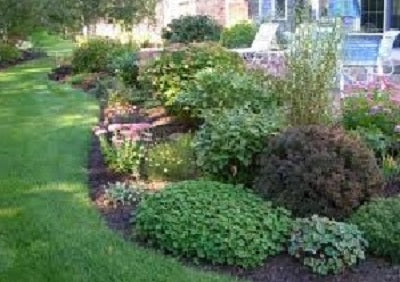
Those new to the area often need help choosing between the many varieties of shrubs. This is my ‘Go-To’ plant list when starting a new landscape design. Each grows exceptionally well at all mountain elevations and offers a good starting point for all landscape styles.
Some online resources are included, many plants available for purchase directly from the grower. I even negotiated free delivery of some shrubs when added to a larger Watters Garden Center delivery and can be picked up directly from Watters.
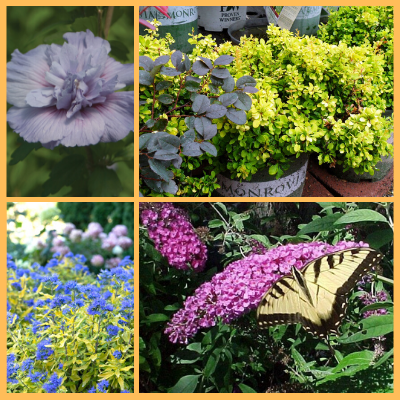
Barberry, Butterfly Bush, Bluebeard Shrub
Barberry is most appreciated for its ability to withstand the worst conditions in garden soils and brings such a large bright spot for such a little plant. Shades of burgundy, golds, reds, and pinks can often be found on the same bush! Barberries are so hardy that they can be planted right next to the driveway and stand up to summer’s fiercest heat. Plant now for season-long interest in containers, raised beds, or right in the ground.
Blue Chiffon Rose of Sharon is packed with summer buds that unfurl into breathtakingly beautiful blue flowers on each strong stem. This vigorous, hardy grower offers summer-through-fall color whether planted as a specimen, or part of a hedge or shrub border.
Bluebeard Shrub adds the spice that furnishes a different aspect to your landscaping. Unlike the other bushes on this list, the fluffy flowers give the plant a soft appearance. The blue blooms of this shrub are beloved by all pollinators, especially our local bumblebee population.
Butterfly Bush naturally draws butterflies to its nectar-rich little flowers, creating a summer- through-autumn parade of these winged garden friends. Single-flower panicles may be up to a foot in length, with each panicle comprised of hundreds of densely packed florets. We have several dwarf varieties that are easy to care for and ideal for smaller gardens.

Deer Grass, Camellia
Deer grass is a knee-high native grass, found in many desert gardens, and loved as a spiky, dependable ornamental. It loves full sun but will grow in a bit of shade. Water every three days until established. After the first year water every three weeks, or less during Summer’s monsoon season.
Ice Angel Camellia blossoms are so glorious that they should be showcased as a high-profile focal point at entryways and for viewing through picture windows. The plant makes a superior foundation cover-up that cloaks featureless walls in shaded exposures. It deserves front yard exhibition or positions at unique focal points around patio or terrace. The beautiful evergreen foliage is well-adapted to the acidic soils beneath oaks, conifers, and junipers.
Gilt Edge Silverberry sports a striking golden-yellow-edged blue leaf that delivers year-round color. A superb native hedge, this plant will hands-down beat Red Tip Photinia in water use and disease resistance. Growing easily to head height or a bit taller, this evergreen thrives in our wind, sun, heat, and cold with virtually no maintenance once established. Amazingly, the silvery spring flowers are tiny but ever so fragrant that they put the scent of lilacs to shame!
Goldflame Spirea is an old-fashioned plant made famous by our grandparents, but it’s still a ‘rock star’ in my garden. It is effortless to grow with little to no maintenance required once established. My personal favorites have bright gold foliage through the summer and just now begin showing their fall colors of purple and reds. The equally brilliant flowers in April are simply a bonus to this garden show-off. Add to the drip irrigation cycle, treat it like any tree growing in the yard, and this plant is happy. It looks delicate, but deer, rabbits, and javelina detest the taste and leave this beauty alone.
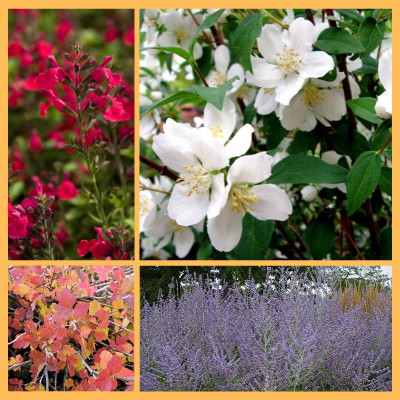
Grow-Low Sumac spreads like a groundcover over hillsides. Sumac bushes are native throughout the mountains of Arizona. They are so easy to grow that here at Watters we have four different varieties in stock. They are available in a ground cover height that stays below knee level, and up to 12′-high towers that almost resemble mountain palm trees but love cold mountain winters. Gardeners new to xeriscape landscaping presume all sumacs are poisonous. Not to worry – we never sell poisonous sumacs here at Watters!
Heatwave Salvia was developed in Australia to withstand extreme weather. As a bonus, it blooms spring through fall, to the delight of hummingbirds and butterflies. Colors include white, pink, red, and salmon.
Lavender is an example of a shrub with a great scent that gets its aroma from its foliage. It often is dried and used in potpourri and sachet bags. The beautiful thing about relying on foliage (rather than flowers) for fragrance is that leaves stay around a lot longer than a plant’s blossoms!
Mock Orange is one of the most popular, fragrant, Prescott spring bloomers. With minimal care, the strongly orange-scented white flowers are guaranteed each spring. The plant grows naturally to 6′ tall and blooms best in full sun.
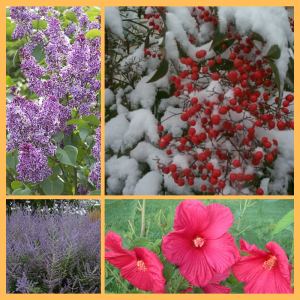
Moscheutos Hibiscus has gorgeous red blooms that are bigger than the largest man’s hand. This summer-blooming perennial has strong upright branches that each spring erupt covered in these vast flowers with equally impressive foliage. Chosen for its tropical appeal and loose cottage style.
Nandina also goes by the name of Heavenly Bamboo. Yes, the evergreen leaves do resemble bamboo, but at our higher elevation, the top of this plant turns bright red during winter. Compact, rarely needs trimming, evergreen, and turns red in the fall – what more could you ask from a landscape plant? Oh, wait, I forgot: this beauty is animal-proof and won’t be eaten by even the hungriest mammals.
Russian Sage is a hip-high blue bloomer that already has been in flower for over a month and won’t stop until the middle of autumn. Water to establish this perennial in year one and never water again. This beauty has perfect blooms for about 10 years then becomes a bit ugly and overgrown. Dig it up and replace it at the first sign of untidy ugliness.
Sensation Lilac is an outstanding lilac noted for its large trusses of purple-red florets edged in white. Branches are erect and open with rich green foliage. An excellent choice to create a beautiful spring flowering hedge, screen, or blooming specimen in the yard. It usually flowers around Mother’s Day.
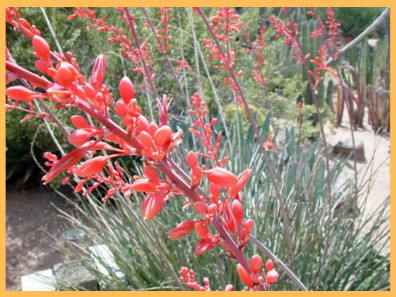
Yucca doesn’t get a lot of respect in the gardening world, but don’t turn your back on this native. Those spiky leaves fend off intruders, and the long taproot anchors it deep in the soil and makes moving it (or killing it) very difficult. Talk about a xeric plant! If the common species is too coarse for you, try one of the variegated varieties. They’re almost as tough, just as architectural, and they deliver a long season of color.

2020 Free Gardening Classes Announcement
January classes and instructors are finalized, and the rest of the Spring schedule is almost completed. Here are the topics for the first classes of 2020:
January 11 @ 9:30 am: Houseplant Designs with Professional Style
January 18 @ 9:30 am: Top Landscape Designs with Flare
January 25 @ 9:30 am: Why January is the Month to Plant Wildflowers
Until next week, I’ll be helping local gardeners here at Watters Garden Center.
Ken Lain can be found throughout the week at Watters Garden Center, 1815 W. Iron Springs Rd in Prescott, or contacted through his web site at WattersGardenCenter.com or FB.com/WattersGardenCenter

